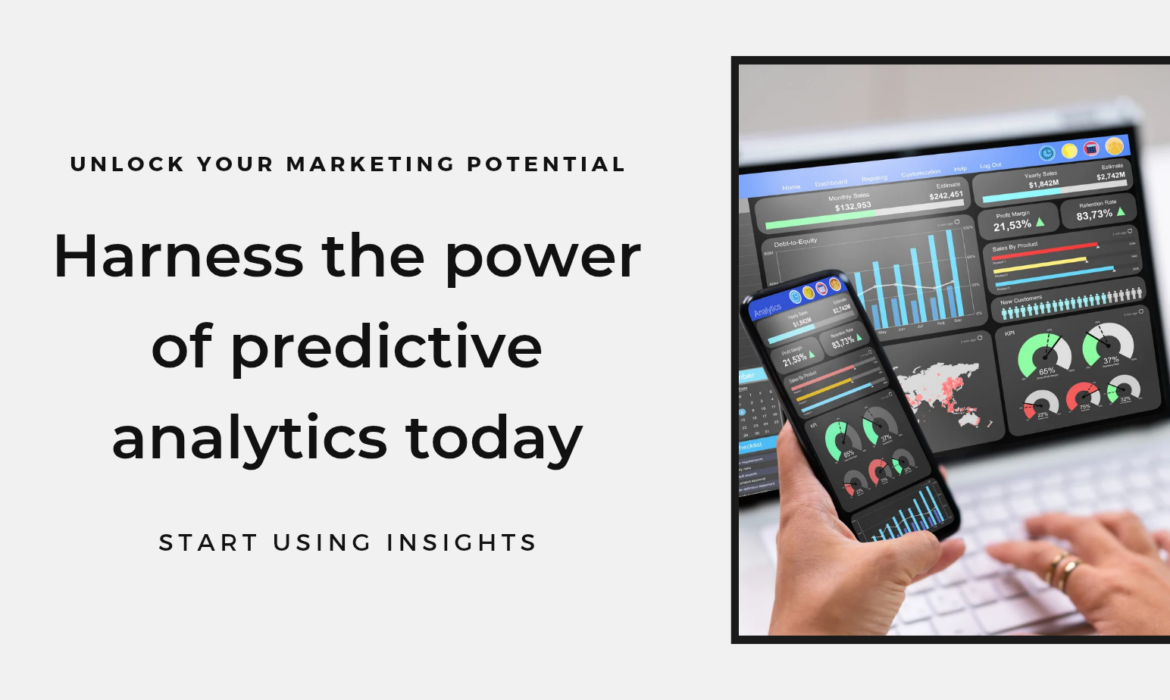081-4797-7173

In today’s data driven world, businesses are constantly seeking ways to stay ahead of the competition by understanding customer behavior and anticipating market trends. Predictive analytics has emerged as a powerful tool in digital marketing, enabling brands to make informed decisions, improve customer experiences, and boost ROI.
This article delves into the concept of predictive analytics, its importance in digital marketing, and actionable strategies to implement it effectively.
What is Predictive Analytics?
Predictive analytics uses historical data, statistical algorithms, and machine learning techniques to identify patterns and predict future outcomes. In the context of digital marketing, it helps marketers anticipate customer behavior, optimize campaigns, and make data backed decisions.
Predictive analytics typically involves:
- Data Collection: Gathering relevant data from various sources such as websites, social media, and CRM systems.
- Model Building: Creating algorithms to identify patterns and trends.
- Forecasting: Using models to predict customer behavior, preferences, and future market trends.
- Forecasting: Using models to predict customer behavior, preferences, and future market trends.
Why is Predictive Analytics Important in Digital Marketing?
Predictive analytics empowers marketers to:
- Personalize Customer Experiences: By understanding individual preferences, brands can deliver tailored messages and offers.
- Optimize Campaigns: Anticipating which strategies will work allows marketers to allocate resources efficiently.
- Enhance Lead Scoring: Identify high potential leads and prioritize efforts accordingly.
- Reduce Churn Rates: Recognize signs of customer dissatisfaction and take proactive measures.
- Boost ROI: Focus on strategies that are likely to yield the best results.
How Predictive Analytics Transforms Digital Marketing
1. Customer Segmentation:
Predictive analytics enables marketers to segment their audience based on behavior, preferences, and purchase history. This allows for more targeted campaigns.
Example:
An ecommerce brand can use predictive analytics to identify customers likely to purchase during sales events and target them with exclusive offers.
2. Personalized Marketing Campaigns:
By analyzing customer data, predictive analytics helps create highly personalized marketing strategies. This includes recommending products, sending customized emails, or displaying relevant ads.
Example:
Streaming platforms like Netflix and Spotify use predictive analytics to recommend content based on user preferences and viewing/listening history.
3. Predicting Customer Lifetime Value (CLV)
Understanding the long term value of a customer helps businesses focus on high value clients. Predictive models can estimate CLV and guide retention strategies.
Example:
A SaaS company might prioritize retaining clients with high CLV by offering them exclusive benefits or personalized support.
4. Lead Scoring and Nurturing
Predictive analytics enhances lead scoring by identifying which leads are most likely to convert. This allows sales teams to focus on high priority prospects while nurturing others.
Example:
A B2B firm could use predictive analytics to analyze website activity, email engagement, and CRM data to score leads and tailor follow up actions.
5. Dynamic Pricing Strategies
Predictive analytics enables businesses to adjust pricing based on demand, competition, and customer behavior.
Example:
Airlines and ride hailing services use predictive analytics to forecast demand and implement surge pricing.
6. Identifying Trends and Market Opportunities
Analyzing data trends helps brands identify emerging markets, product opportunities, and consumer needs.
Example:
A fashion retailer might use predictive analytics to identify trending colors or styles for the upcoming season and adjust inventory accordingly.
How to Implement Predictive Analytics in Digital Marketing
1. Collect and Organize Data:
Data is the foundation of predictive analytics. Gather data from multiple sources, including:
- Website analytics (Google Analytics, etc.).
- Social media insights.
- Customer relationship management (CRM) tools.
- Email marketing platforms.
Organize this data in a centralized system for easy access and analysis.
2. Choose the Right Tools
Leverage predictive analytics software and tools to analyze data and build predictive models. Some popular tools include:
- Google Analytics 4
- Salesforce Einstein
- IBM Watson Analytics
- Tableau
- SAS Predictive Analytics
Ensure the tool you choose integrates seamlessly with your existing marketing stack.
3. Define Clear Objectives
Identify what you want to achieve with predictive analytics, such as:
- Increasing customer retention
- Improving ad targeting
- Enhancing email open rates
Having clear objectives will guide your strategy and ensure focused efforts.
4. Develop Predictive Models
Work with data scientists or use machine learning tools to build models that analyze historical data and forecast future trends. Common predictive models include:
- Regression Analysis: Predicting numerical outcomes (e.g., revenue growth).
- Classification Models: Categorizing data (e.g., identifying high risk customers).
- Clustering: Grouping similar data points (e.g., customer segmentation).
5. Test and Optimize
Before fully implementing your predictive analytics strategy, test your models on smaller campaigns to ensure accuracy. Continuously refine your models based on results.
6. Integrate Predictive Insights
Use the insights from predictive analytics to:
- Tailor marketing messages.
- Allocate budgets more effectively.
- Optimize ad placements and bidding strategies.
Challenges of Predictive Analytics in Digital Marketing
1. Data Quality
Poor quality data can lead to inaccurate predictions. Ensure your data is clean, complete, and up to date.
2. Complexity
Building predictive models requires expertise in data science and machine learning. Consider hiring skilled professionals or outsourcing to analytics firms.
3. Privacy Concerns
With growing data privacy regulations, ensure compliance with laws like GDPR and CCPA when collecting and using customer data.
Conclusion
Predictive analytics is revolutionizing digital marketing by enabling businesses to anticipate customer behavior, optimize campaigns, and achieve better results.
By leveraging this powerful tool, marketers can make data driven decisions, deliver personalized experiences, and stay ahead of the competition.
While implementing predictive analytics requires effort and investment, the long term benefits far outweigh the challenges.
Start incorporating predictive analytics into your digital marketing strategy today to unlock its full potential and drive your business forward.
0






